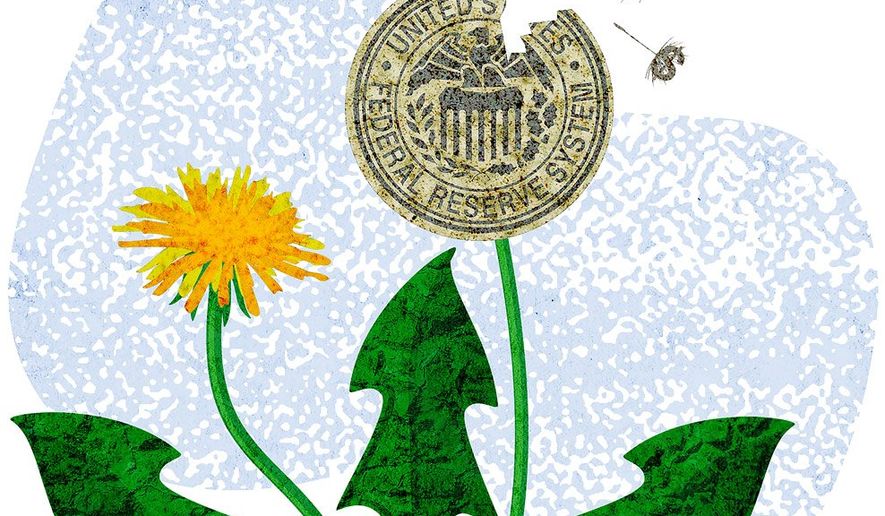OPINION:
The Federal Reserve’s principal tools — adjusting short term interest rates and quantitative easing for accomplishing 2 percent inflation and low unemployment — are radically out of sync with a global economy that relies on the dollar. It’s high time U.S. monetary policy be realigned to reflect the reality of managing the global currency.
Since the financial crisis, inflation has unhinged from Fed policy. Annual movements in the consumer price index, less food and energy, have largely fluctuated between 1 and 2 percent whether unemployment exceeded 10 percent, the Fed set short rates near zero and it bought long term Treasuries and mortgage backed securities, or unemployment fell below 4 percent, the Fed raised short rates and ran down its balance sheet.
With the U.S. economy so open — not just to imports of manufactures from China but also products from emerging Asian nations eager to replace the Middle Kingdom’s cheap hands and an increasing array of services from places like India thanks to the Internet — the global supplies of labor, capital and technology remain remarkably plentiful despite low U.S. unemployment and stronger growth.
President Trump’s tariffs won’t change much. If iPhones aren’t assembled in China, production will move elsewhere — and services are immune from tariffs and many border regulations.
To lubricate global supply chains and hedge uncertainty, businesses and investors everywhere have turned to the dollar as the one major currency that is well managed — not subject to arbitrary regulation like the Chinese yuan — and likely to hold its value — not threatened with extinction from political upheavals like the euro.
More than 40 percent of all cross border trade and 60 percent of international debt financing is denominated in dollars, even though the United States is less than one-fifth of the global economy. Foreign banks, businesses and individual investors of all sizes now hold dollar denominated securities, monetarizing U.S. foreign policy.
Whereas China throws billions around through its Belt and Road Initiative — attempting to win friends but alienating many governments with high-handed tactics — U.S. banks — for example, Citibank — have built transnational payment systems that provide the plumbing for global commerce and finance. And the Treasury Department can turn the valve on rogue regimes like Iran and terrorist groups with financial sanctions.
Sadly, U.S. monetary policy has not been similarly globalized making it substantially impotent.
Historically, the Fed raised the bank overnight lending rate — the so called Federal Funds rate — when it wanted to tap the breaks on growth and inflation. In the 20th century, this would push up rates for short-term business loan rates and long rates on Treasury securities, corporate debt and mortgages.
These days, when long rates move up, all those foreign actors holding dollars abroad can use the Citibank pipeline and similar facilities to access higher U.S. yields and push those rates back down. When Ben Bernanke raised the federal funds rate in 2004-2006, longer-term Treasury rates hardly budged, and when the Fed pushed up short rates three times in 2017, long rates were similarly stubborn.
Foreign monetary authorities hold over $5 trillion in U.S. Treasury and mortgage backed securities, corporate bonds and stocks to back up their currencies and they purchase and sell these to lower or raise the value of their currency against the dollar to stimulate or break their domestic economies and influence interest rates on U.S. securities.
Last year, as the Trump administration imposed tariffs on Chinese goods, Chinese monetary authorities permitted the yuan to fall against the dollar, partially frustrating U.S. efforts to reduce imports and boost manufacturing.
The Fed — despite controlling the supply of one truly global currency — does not have similarly large holdings of highly rated German, Japanese, Chinese and other major currency securities but it should. Then as it sells U.S. securities — as it has recently with the potential to raise long term rates — it could sell foreign securities to also push up rates on those debt instruments. This would mitigate the flood of foreign investors into U.S.securities and permit U.S. long rates to rise with more certainty.
The same would apply when it undertakes quantitative easing to boost the economy.
With such recognition that monetary policy must be executed on the global stage — and not merely on the trading floors for U.S. bonds in New York — the Fed’s efforts to make effectively accomplish its goals would not be frustrated by its current xenophobic mentality.
• Peter Morici is an economist and business professor at the University of Maryland, and a national columnist.




Please read our comment policy before commenting.